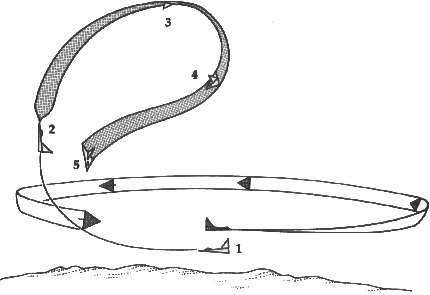The Official F-15 Strike Eagle Handbook
by Richard Sheffield
Head-On Maneuvers
Many dogfights start from a neutral head-on pass after both parties have survived an initial missile exchange. Remember, it's mission first. You always have the option of not turning and fighting after a head-on pass. If you're close to your ground target, you may want to consider this option, but if you do choose to go toe-to-toe with the bogey, here are a few moves that might help you gain the advantage.
Pitch Back
Situation: You're attacking your opponent head-on with at least 500 knots of airspeed.
Maneuver:
You're in a head-on pass (1).
Pull up into a loop maneuver (2).
At the top of the loop, keep the stick pulled back (3).
When you're heading straight toward the ground, start to turn toward the enemy while pulling out of the dive (4).
Instead of finishing the loop heading in your original direction, you've turned on the way down and should finish in a hard turn behind your opponent (5).
This kind of maneuver is called an out-of-plane—you're maneuvering in the vertical plane while your opponent is in a flat turn. This is a very good opening move if you suspect you can't out-turn your opponent due to greater airspeed. Use your energy advantage to go vertical.

This maneuver looks tricky—and it is. Pull back hard on the stick, loop, and then turn behind the target if it's there.
Head-On Gun Attack
Situation: You're approaching enemy aircraft head-on. You're too close for a missile shot, but you can still take a guns shot before he flashes past you.
Maneuver:
Line up with the enemy straight ahead, at the same altitude (1).
Start firing when the enemy is approximately 1½ radar screen divisions away. The target will fly to meet the gun shells. If you wait until the enemy aircraft is within normal gun range, you'll fly past before you get a good shot (2).
NOTE |
A head-on attack presents a bad missile angle for your opponent. If you make the enemy pilot waste one of his missiles during the head-on pass, so much the better. Be prepared to jink, though. |

Fire while the enemy aircraft is still out of range in a head-on cannon attack.
Head-On Turning Attack
Situation: You're approaching an opponent head-on at slow speed (400-500 knots). This speed allows maximum turning performance, which is to your advantage. Remember to increase the throttle during the turn to prevent a stall.
Maneuver:
Head slightly to one side of your opponent to get some lateral separation during the initial pass (1).
Turn hard toward your opponent as you pass (2).
Maintain this maximum-G turn. You may need to increase power during the turn to keep your speed up to 400 knots (3).
If you can out-turn your opponent, you should get a missile shot (4).
This isn't a long-term maneuver. If you don't gain an advantage fairly quickly, be ready to disengage or attempt another maneuver, such as a Low Yo-Yo. Spinning around and around with a single bogey will likely draw a number of his buddies to the area. Don't get so wrapped up that you let another bogey come in and gun you down.

Your turning performance must be better than your opponent's for this maneuver to work.
A Series of Low Yo-Yos
After a head-on pass, you can use a series of Low Yo-Yo maneuvers (described and illustrated earlier) to pull around on the tail of the bogey. This maneuver can be used even if you don't have a turning advantage over your opponent.
Yo-Yo maneuvers are some of the best moves you can learn. Master them, and they'll come in handy in a number of situations.
Table of Contents
Previous Section: ACM Checkride 3
Next Section: ACM Checkride 4
